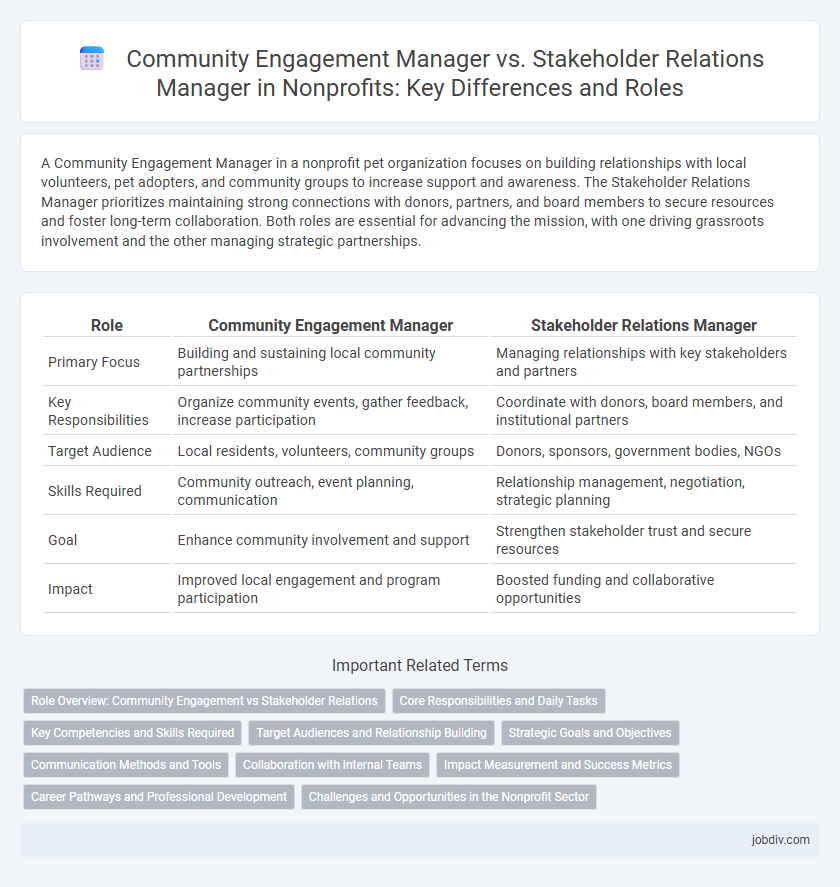A Community Engagement Manager in a nonprofit pet organization focuses on building relationships with local volunteers, pet adopters, and community groups to increase support and awareness. The Stakeholder Relations Manager prioritizes maintaining strong connections with donors, partners, and board members to secure resources and foster long-term collaboration. Both roles are essential for advancing the mission, with one driving grassroots involvement and the other managing strategic partnerships.
Table of Comparison
| Role | Community Engagement Manager | Stakeholder Relations Manager |
|---|---|---|
| Primary Focus | Building and sustaining local community partnerships | Managing relationships with key stakeholders and partners |
| Key Responsibilities | Organize community events, gather feedback, increase participation | Coordinate with donors, board members, and institutional partners |
| Target Audience | Local residents, volunteers, community groups | Donors, sponsors, government bodies, NGOs |
| Skills Required | Community outreach, event planning, communication | Relationship management, negotiation, strategic planning |
| Goal | Enhance community involvement and support | Strengthen stakeholder trust and secure resources |
| Impact | Improved local engagement and program participation | Boosted funding and collaborative opportunities |
Role Overview: Community Engagement vs Stakeholder Relations
Community Engagement Managers focus on building and maintaining active relationships within local communities to promote nonprofit initiatives and encourage volunteer participation. Stakeholder Relations Managers prioritize managing relationships with key external partners such as donors, government agencies, and corporate sponsors to secure funding and strategic support. Both roles require strong communication skills but differ in their target audiences and engagement strategies tailored to community involvement versus high-level stakeholder collaboration.
Core Responsibilities and Daily Tasks
Community Engagement Managers coordinate outreach programs, develop volunteer initiatives, and foster relationships with local groups to boost participation and support. Stakeholder Relations Managers focus on maintaining communication with key stakeholders, addressing concerns, and aligning organizational goals with stakeholder interests for sustained partnerships. Both roles require strategic planning and strong interpersonal skills, but Community Engagement emphasizes grassroots involvement while Stakeholder Relations centers on high-level interactions.
Key Competencies and Skills Required
A Community Engagement Manager requires strong skills in outreach, communication, and event coordination to effectively mobilize volunteers and foster local partnerships. In contrast, a Stakeholder Relations Manager focuses on negotiation, relationship management, and strategic communication to maintain long-term partnerships with donors, government agencies, and corporate sponsors. Both roles demand proficiency in data analysis and reporting to measure engagement impact and inform decision-making.
Target Audiences and Relationship Building
Community Engagement Managers focus on fostering connections with local residents, volunteers, and grassroots organizations to enhance program participation and community impact. Stakeholder Relations Managers prioritize maintaining strategic relationships with donors, board members, government officials, and corporate partners to secure funding and support for the nonprofit's mission. Both roles require tailored communication strategies and trust-building efforts but differ in their primary audiences and engagement objectives.
Strategic Goals and Objectives
Community Engagement Managers drive nonprofit success by fostering active participation through grassroots initiatives and volunteer programs aligned with strategic goals of inclusion and local impact. Stakeholder Relations Managers focus on cultivating and maintaining relationships with donors, partners, and board members to secure funding and influence policy aligned with organizational objectives. Both roles are critical in advancing mission-driven outcomes, with Community Engagement emphasizing community mobilization and Stakeholder Relations concentrating on resource development and advocacy.
Communication Methods and Tools
Community Engagement Managers leverage digital platforms such as social media, email campaigns, and virtual town halls to foster two-way communication with local residents and volunteer groups, emphasizing interactive dialogue and grassroots participation. Stakeholder Relations Managers utilize formal communication methods including reports, presentations, and strategic meetings supported by CRM software to maintain transparent, data-driven communication with donors, partners, and board members. Both roles prioritize tailored messaging, but Community Engagement focuses on broader public interaction while Stakeholder Relations targets high-level relationship management.
Collaboration with Internal Teams
A Community Engagement Manager fosters collaboration by coordinating with program staff, marketing, and volunteer teams to align outreach efforts and maximize community impact. A Stakeholder Relations Manager works closely with leadership, fundraisers, and communication departments to build strategic partnerships and ensure stakeholder alignment with organizational goals. Both roles require seamless interdepartmental communication to enhance nonprofit effectiveness and foster sustainable relationships.
Impact Measurement and Success Metrics
Community Engagement Managers prioritize impact measurement through direct community feedback, volunteer engagement rates, and program participation metrics to assess social outcomes. Stakeholder Relations Managers focus on success metrics linked to partnership growth, funding secured, and stakeholder satisfaction surveys to gauge organizational support. Both roles utilize qualitative and quantitative data, but the former emphasizes grassroots impact while the latter centers on strategic relationship effectiveness.
Career Pathways and Professional Development
Community Engagement Managers often start with roles in volunteer coordination or outreach, progressing through acquiring skills in event planning, public speaking, and digital communication to enhance community involvement. Stakeholder Relations Managers typically emerge from backgrounds in public relations or corporate affairs, developing expertise in negotiation, strategic communication, and stakeholder analysis to manage diverse interests effectively. Career pathways in both roles emphasize professional development through certifications in nonprofit leadership, conflict resolution, and data-driven impact assessment to advance organizational goals and personal growth.
Challenges and Opportunities in the Nonprofit Sector
Community Engagement Managers face challenges in mobilizing diverse volunteers and fostering local partnerships while leveraging opportunities to enhance grassroots support and increase program visibility. Stakeholder Relations Managers grapple with balancing the needs of funders, board members, and beneficiaries, creating opportunities to strengthen donor loyalty and secure sustainable funding streams. Both roles require strategic communication skills and adaptability to navigate the complex nonprofit ecosystem and drive mission success.
Community Engagement Manager vs Stakeholder Relations Manager Infographic

 jobdiv.com
jobdiv.com